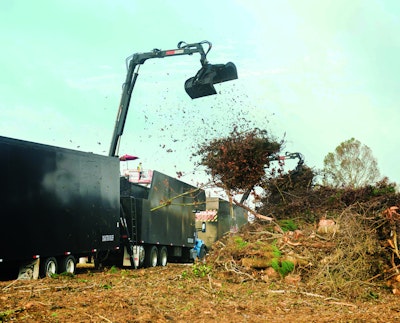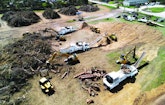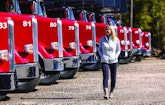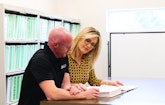Interested in Business?
Get Business articles, news and videos right in your inbox! Sign up now.
Business + Get AlertsIn late September 2022, Hurricane Ian devastated Southwestern Florida when it came ashore as a Category 4 in Lee County. Seaside communities such as Fort Myers, Sanibel, Fort Myers Beach, Bonita Springs plus the village of Estero and Lee County’s unincorporated areas were smashed by the storm — resulting in millions of cubic yards of debris being piled by their roadsides, waiting to be cleared so that rebuilding could begin.
CrowderGulf, a family-owned disaster recovery/debris removal company headquartered in Mobile County, Alabama, was under contract with Lee County, Florida when this happened. As such, CrowderGulf was assigned full responsibility for debris management. This included removing everything from broken building construction materials and destroyed vegetation to damaged electronics, appliances and hazardous household waste.
Once collected by truck, these items were taken to debris management sites for temporary storage and sorting into rows. For example, the construction and vegetative debris rows were separated and then processed using a grinder. The construction material went into landfills while the ground-up vegetation was reused as biomass fuel, landfill cover or mulch.
Coming to the rescue is nothing new for CrowderGulf. Since its inception, the company has handled more than 500 disaster recovery/debris removal projects in the United States, and moved over 400 million cubic yards of debris. Today, the company employs an army of full-time staff and subcontractors.
“Essentially, CrowderGulf is a full-service disaster response management company,” Ashley Ramsay-Naile says. She is the current president of the company, having succeeded her father John Ramsay after he passed away in 2021. “Our job is to go in after the disaster, working with the municipalities to see exactly what they need to recover from a standpoint of getting the debris off the streets and disposed of.”
HUMBLE BEGINNINGS
CrowderGulf owes its existence to Hurricane Camille, a Category 5 monster storm that tore through the South Central and Southeast U.S. in August 1969. Brothers John and Woodie Ramsay were living in Grand Bay, Alabama, when Camille hit, having moved back home after graduating from Auburn University. The hurricane devastated their family’s farm and the surrounding area, which motivated the brothers to pitch in with the recovery effort afterward.
In 1984, John and Woodie Ramsay established Gulf Equipment Corporation to support the growing telecom industry, with John Ramsay remaining involved in debris management as well. The growth of this secondary business led him to found CrowderGulf in 1994.
“It was Hurricane Frederic back in 1979, which went through Mississippi and Alabama, that catapulted Dad into the world of disaster recovery and debris removal,” Ramsay-Naile says. “He loved the idea of going in and helping communities at their worst and really just fell in love with it.”
Ramsay-Naile, a 1989 graduate of the University of South Alabama, started working full time with her father at CrowderGulf during the 2004 hurricane season. After four hurricanes hit Florida, John, Ashley and their top managers took a look at the disaster management/debris removal business as a whole to identify opportunities for growth. They then developed a plan to expand services in the regions most likely to need their help.
“We developed a 10-year goal to expand the company by establishing regional managers on the East Coast, southern Florida and the Gulf states including the entire state of Texas,” Ramsay-Naile recalls. “So we strategically started adding to our management team and developed a nationwide subcontractor database identifying equipment, operators and haulers.”
Finding companies that could provide helpful equipment was important, but the team at CrowderGulf also looked beyond machinery. “It was most important to us that we recruit people with the same work ethic and goal to help in disaster-affected communities. In doing so, we built a very strong team of talented and committed individuals, the best of the best in the recovery world.”
A MANAGED APPROACH
The secret to CrowderGulf’s success is its network of satellite offices with experienced management and team of dedicated subcontractors. “Their people and their equipment only work for us when there’s a disaster,” she says. Their efforts are coordinated through CrowderGulf’s innovative Disaster Administration Office, which Ramsay-Naile created and has managed since.
According to CrowderGulf’s data, the company and its subcontractors have access to about 1,600 pieces of owned and leased earth-moving, trucking and other heavy equipment. Manufacturers range from Peterbilt Trucks to Caterpillar and John Deere. This gives them the machinery and crew output required to cope with massive projects like the Hurricane Ian cleanup.
CrowderGulf’s DAO manage and preplan the efforts, resulting in a successful approach to disaster management. As much as possible, the logistics and layout of debris removal and related operations are worked out before a disaster actually strikes so CrowderGulf’s people are ready to respond as soon as possible.
“We have signed contracts for exclusivity rights with what we call our ‘in-house subcontractors,’” says Reid Loper, CrowderGulf’s executive vice president. “Five or six of them only work for us. As well, we have somewhere in the ballpark of $200 million worth of equipment that we have access to. This includes around a hundred of what we call ‘self-loading debris trucks,’ which are tandem truck and trailer combos that haul about 160 cubic yards of debris per trip. And then we have ‘push equipment:’ loaders, skid-steer loaders, excavators and things of that nature. That’s going to be a couple of hundred pieces of equipment in itself.”
Add in grinders plus the many “walking floor” specialized trailers that haul processed materials from the debris management sites to final disposal, and “we have about 500 pieces of equipment for immediate deployment that are provided to CrowderGulf under exclusive lease agreements,” Loper says.
RESPONSE HELP
CrowderGulf’s management team works hard to establish and maintain a positive informed relationship with every client and part of that comes from the company’s competitively bid pre-event contracts in place prior to a disaster.
A key to CrowderGulf’s responsiveness also comes from its relationship with subcontractors. “As a company, you can’t own enough equipment to do some of these larger disasters,” Ramsay-Naile says. “So we have strategically aligned ourselves with subcontractors on a long-term basis. The youngest subcontractor has worked for us for 12 years while others such as Steve St. George have been with us for 20 years now. So that’s the key to our success: It’s not about how much equipment we own, it’s how much equipment we can get rolling with a single phone call.”
Year-round planning is also central to CrowderGulf’s process. “This is not a ‘we’re only in business whenever a storm is occurring’ situation,” Loper says. “We have hundreds of standby contracts that sit on the shelf. They provide us and local municipalities with the mechanisms we need to start work immediately after a disaster occurs.”
When a disaster threatens to impact the company’s clients, its preplanning process identifies critical issues and equipment that may be needed. When this happens, CrowderGulf’s people do assessments of the damage and — with their clients — evaluate the immediate, short-term and long-term needs, at which point CrowderGulf assigns the appropriate assets.
The company also has regional managers strategically placed throughout the United States to train clients through mock hurricane landfall exercises to ensure that the right emergency contacts are in place, and to use what they call “blue sky days” to identify debris management sites that can immediately get up and running after a disaster to receive debris. This approach works both for “no-
notice” events like tornadoes as well as hurricanes that provide some degree of warning.
The company’s knowledgeable management team combined with this strategic approach to subcontractors have allowed CrowderGulf to move into related service areas such as demolition, emergency berm and levee construction, site preparation, road and utility work, and cellular tower construction. The company also offers marine surveying, coastal restoration, recycling and pre-disaster training for clients in debris management and preparedness planning.
LEARNING FROM DISASTER
CrowderGulf has learned many lessons through the events it has dealt with to date. But the one lesson that sticks with Reid Loper the most is the fact that every storm is different. “There cannot be a more true statement,” he says. “So you have to be flexible. For instance, with Hurricane Ian, we had to actually float large equipment over to Sanibel Island because their one and only bridge to get to the mainland was completely destroyed. For about three weeks, we were completely barging equipment, fuel and personnel over pretty much on a daily basis to make our operations run.”
Given its success to date, CrowderGulf has learned this lesson and many others well. In fact, “after every disaster, I think we learn something new,” says Ramsay-Naile. “And the one thing about the CrowderGulf team that makes us stand out is we’re always implementing the lessons that we’ve learned. That’s the culture that we have strived for, and the approach to this industry that my father understood and applied, because he always was a big-picture kind of guy.”














